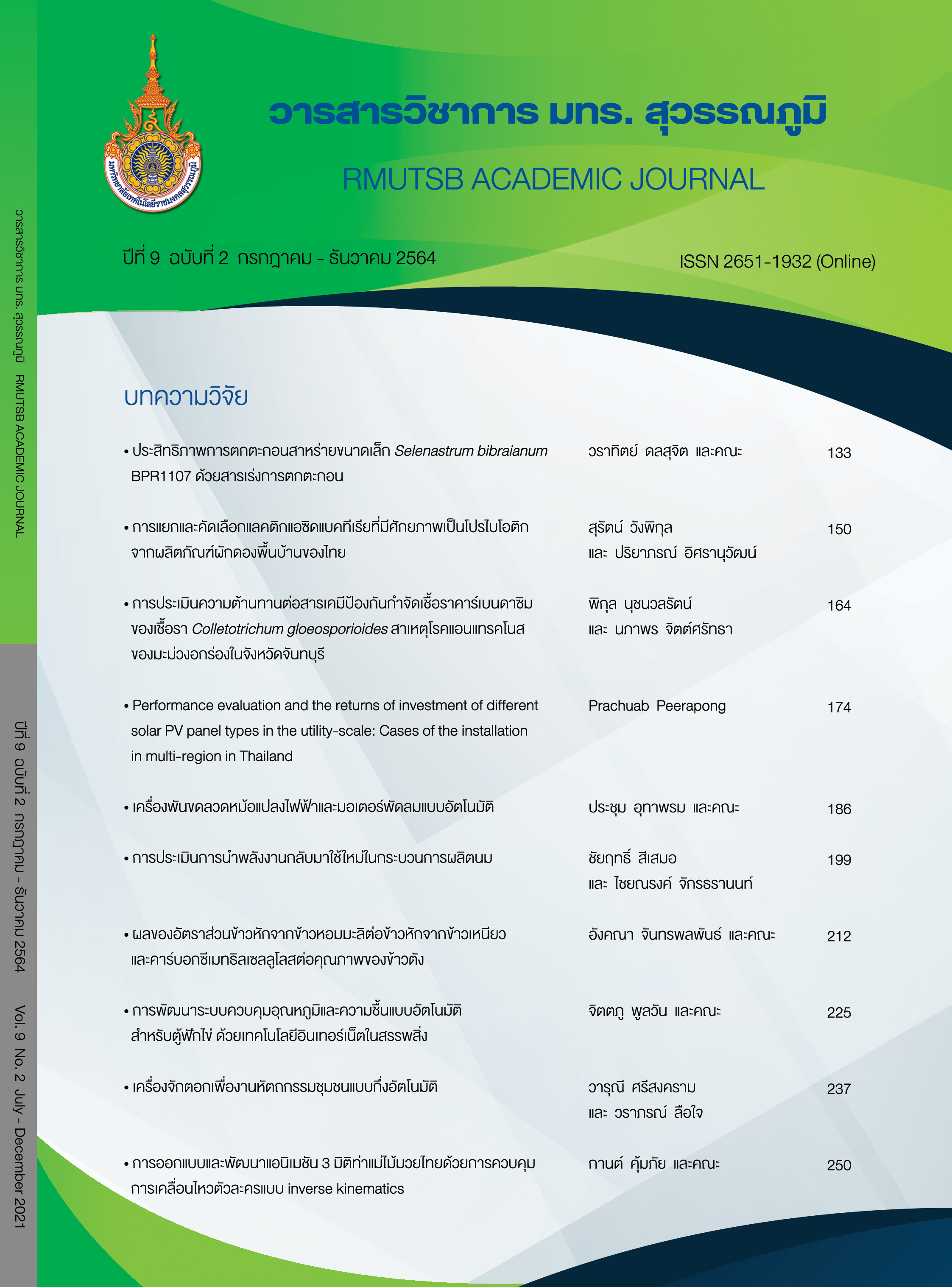Effects of broken jasmine to glutinous rice ratio and carboxymethyl cellulose on the quality of rice cracker
Main Article Content
Abstract
The objectives of this study were to investigate the effects of the ratio of broken Thai jasmine rice cultivar (Khao Dawk Mali 105; KDML 105) to broken Thai glutinous rice cultivar (RD6) on physical and sensory properties of rice cracker. The effects of carboxymethyl cellulose (CMC) at different concentrations on physical and sensory properties of rice cracker were also studied. The rice cracker was prepared from broken KDML 105 (14.61% amylose content) and broken RD6 (4.561% amylose content) at ratios of 100:0, 75:25, 50:50, 25:75 and 0:100. It was found that volume expansion ratio of the rice crackers significantly increased with increasing the ratio of broken RD6 rice (p0.05), which resulted in a significant decrease in hardness of the rice crackers (p
0.05). Color parameters (L*, a*, and b*) of the rice crackers were not significantly affected by the ratio of broken KDML 105/ broken RD6 (p>0.05). Based on sensory evaluation using a 7-point hedonic scale, the rice crackers prepared from the ratio of 25:75 and 0:100 broken KDML 105/broken RD6 obtained higher score than that of ratio of 100:0, 75:25 and 50:50 broken KDML 105/ broken RD6. The physical and sensory properties of the rice cracker affected by different concentrations of CMC were examined. The experiments were varied concentrations of CMC at 4 levels: 0, 1.5, 3 and 4.5%, w/w of broken rice. The results were suggested that the volume expansion ratio and the color a* and b* of the rice crackers were not affected by the addition of CMC at the studied contents (p>0.05), whereas the rice cracker with the addition of 4.50% CMC showed the highest sensorial score of overall acceptability attributes (p
0.05).
Article Details
Published manuscript are the rights of their original owners and RMUTSB Academic Journal. The manuscript content belongs to the authors' idea, it is not the opinion of the journal's committee and not the responsibility of Rajamangala University of Technology Suvarnabhumi
References
AOAC. (1990). Official methods of analysis (15th ed.). Washington DC, USA: The Association of Official Analytical Chemists.
Inprasit, K., Mongkonchart, P., & Chookaew, L. (2019). Functional properties of mixed broken rice with hydrocolloids for textural improvement of rice cracker. Proceeding of the 2nd Suan Sunandha National and International Academic Conference on Science and Technology (pp. 198-209). Bangkok: Suan Sunandha Rajabhat University. (in Thai)
Jiamjariyatam, R., Kongpensook, V., & Pradipasena, P. (2015). Effects of amylose content, cooling rate and aging time on properties and characteristics of rice starch gels and puffed products. Journal of Cereal Science, 6, 16-25.
Jiamjariyatam, R. (2016). Development of ready-to-eat rice starch-based puffed products by coupling freeze-drying and microwave. International Journal of Food Science and Technology, 51, 444-452.
Jiranuntakul, W., Puttanlek, C., Rungsardthong, V., Puncha-arnon, S., & Uttapap, D. (2011). Microstructural and physicochemical properties of heat-moisture treated waxy and normal starches. Journal of Food Engineering, 104, 246-258.
Juliano, B. O. (1971). A simplified assay for milled-rice amylose. Journal of Cereal Science, 16, 334-340.
Juliano, B. O. (1985). Criteria and tests for rice grain qualities. In B. O. Julaino (Ed.), Rice chemistry and technology (pp. 443-514). St. Paul, MN: American Association of Cereal Chemists.
Kim, J. S., & Koh, B. K. (2019). Rice varieties in relation to saltine rice cracker quality. International Journal of Food Properties, 22(1), 1899-1909.
Kongpan, S. (1997). Appetizer and beverage. Bangkok: Sangdad. (in Thai)
Mortero, L. (2009). Thai traditional knowledge encyclopedia: foods from four regions. Bangkok: Biodiversity-Based Economy Development. (in Thai)
Nammakuna, N., Suwansri, S., Thanasukan, P., & Ratanatriwong, P. (2009). Effects of hydrocolloids on quality of rice crackers made with mixed-flour blend. Asian Journal of Food and Agro-Industry, 2(04), 780-787.
Noosuk, P., Hill, S. E., Pradipasene, P., & Mitchell, J. R. (2003). Structure-viscosity relationships for Thai rice starches. Starch/Stake, 55, 337-344.
Oumaree, K., & Khawnyao, S. (2014). Using of hydrocolloid in the production of snack from broken red jasmin rice. Proceeding of the Integration of Thai Research within the ASEAN Community Network (pp. 346-353). Phuket: Phuket Rajabhat University. (in Thai)
Pholva, M., Chantaraponpan, A., & Paseephol, T. (2017). Effect of grain development on physical and chemical properties of black glutinous rice. Khon Kaen Agriculture Journal, 45(1)(Suppl.), 1099-1104. (in Thai)
Pholva, M., Chantaraponpan, A., & Paseephol, T. (2018). Chemical and physical characteristics of red glutinous rice at three development stages after flowering. Khon Kaen Agriculture Journal, 46(1)(Suppl.), 526-532. (in Thai)
Rosell, C. M., Haros, M., Escrivá C., & Benedito de Barber, C. (2001). Experimental approach to optimize the use of -amylases in bread making. Journal of Agricultural and Food Chemistry, 49(6), 2973-2977.
Sirivongpaisal, P., Hill, S. E., Pradipasena, P., & Mitchell, J. R. (2005). Amylose content and amylopectin Fine structure of Thai rice starches. Proceeding of Starch Update 2005: Bio Thailand 2005. The 3rd Conference on Starch Technology (pp. 221-226). Bangkok: BIOTEC.
Srisorn, P., Boontaganon, P., Sopanangkul, A., & Terapatponchai, Y. (2021). The optimum condition of pre-gelatinized Hom Nil rice flour production by using double drum dryer. RMUTSB Academic Journal, 8(2), 199-214.
Thai rice mill association. (2015). Rice prices report. Retrieved January 17, 2021, from http://www.thairicemillers.org/index.php?lay=show&ac=article&Id=2147529303&Ntype=19 (in Thai)
Thammarutwasik, P., Adulyatham, P., Thongraung, C., & Sridach, W. (2002). Production of puffed rice for health (research report). Songkhla: Prince of Songkla University. (in Thai)
Villareal, C. P., & Juliano, B. O. (1987). Varietal differences in quality characteristic of puffed rice. Cereal Chemistry, 64, 337-342.
Wongsa, J., Silapruang, S., Aeimsard, R., & Thumthanaruk, B. (2013). Effect of jasmine rice on puff quality of glutinous rice crackers filled with chili fish paste. Agricultural Science Journal, 44(2)(Suppl.), 329-332. (in Thai)


